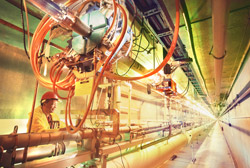The Large Hadron Collider
Our understanding of the Universe is about to change...
The Large Hadron Collider (LHC) is a gigantic scientific instrument near Geneva, where it spans the border between Switzerland and France about 100m underground. It is a particle accelerator used by physicists to study the smallest known particles – the fundamental building blocks of all things. It will revolutionise our understanding, from the minuscule world deep within atoms to the vastness of the Universe.Two beams of subatomic particles called "hadrons" – either protons or lead ions – travel in opposite directions inside the circular accelerator, gaining energy with every lap. Physicists use the LHC to recreate the conditions just after the Big Bang, by colliding the two beams head-on at very high energy. Teams of physicists from around the world then analyse the particles created in the collisions using special detectors in a number of experiments dedicated to the LHC.
There are many theories as to what will result from these collisions. For decades, the Standard Model of particle physics has served physicists well as a means of understanding the fundamental laws of Nature, but it does not tell the whole story. Only experimental data using the high energies reached by the LHC can push knowledge forward, challenging those who seek confirmation of established knowledge, and those who dare to dream beyond the paradigm.
How an accelerator works
Accelerators were invented to provide energetic particles to investigate the structure of the atomic nucleus. Since then, they have been used to investigate many aspects of particle physics. Their job is to speed up and increase the energy of a beam of particles by generating electric fields that accelerate the particles, and magnetic fields that steer and focus them. An
accelerator comes either in the form of a ring (circular accelerator),
where a beam of particles travels repeatedly round a loop, or in a
straight line (linear accelerator), where the beam travels from one end
to the other. A number of accelerators may be joined together in
sequence to reach successively higher energies, as at the accelerator complex at CERN.
An
accelerator comes either in the form of a ring (circular accelerator),
where a beam of particles travels repeatedly round a loop, or in a
straight line (linear accelerator), where the beam travels from one end
to the other. A number of accelerators may be joined together in
sequence to reach successively higher energies, as at the accelerator complex at CERN.The main components of an accelerator include:
- Radiofrequency (RF) cavities and electric fields – these provide acceleration to a beam of particles. RF cavities are located intermittently along the beam pipe. Each time a beam passes the electric field in an RF cavity, some of the energy from the radio wave is transferred to the particles.
- Vacuum chamber – this is a metal pipe (also known as the beam pipe) inside which a beam of particles travels. It is kept at an ultrahigh vacuum to minimise the amount of gas present to avoid collisions between gas molecules and the particles in the beam.
- Magnets – various types of magnets are used to serve different functions. For example, dipole magnets are usually used to bend the path of a beam of particles that would otherwise travel in a straight line. The more energy a particle has, the greater the magnetic field needed to bend its path. Quadrupole magnets are used to focus a beam, gathering all the particles closer together (similar to the way that lenses are used to focus a beam of light).

No comments:
Post a Comment